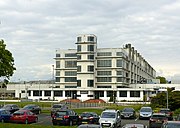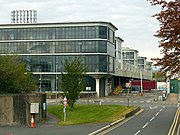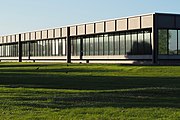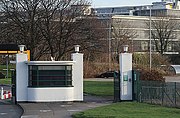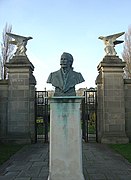Boots Factory Site
History
John Boot (1815–1860) opened a shop selling herbal remedies in Goosegate in the City of Nottingham in 1849. Over the next 70 years his son, Jesse Boot, through a series of innovations; trading only in cash, the use of large-scale industrial production methodologies, the establishment of a major distribution and retailing network including the opening of over a thousand stores allowing direct selling, and the development of pharmacies which enabled him to undercut the prescription prices previously charged by doctors; expanded the business to become one of the world's biggest drug companies. In 1920, concerned as to whether his son, John had the commercial acumen necessary to run the company, Jesse Boot sold it to the United Drug Company of America. By 1926, John Boot had bought back the company and in 1927, renamed the Boots Pure Drug Company, it purchased a new 200-acre (81 ha) site at Beeston, outside of Nottingham, which became the Boots Factory Site.
Work began immediately and Owen Williams, an architect and engineer, was engaged to design a range of buildings on the site. The first was D10, the 'Wets' building, so-called because it was used for the manufacture and packaging of lotions and medicines in liquid form. This was constructed between 1930 and 1932 and was followed between 1935 and 1938 by D6, the 'Drys' building, used for production of tablets and lozenges. Williams went on to design a fire station, D34, for the plant. In the 1960s, the American firm Skidmore, Owings & Merrill was commissioned to design D90, the company headquarters, after Boots' executives had seen examples of their work in the United States.
The Beeston site remains the headquarters of Boots UK Limited in the 21st century, although the company is now owned by the American pharmacy chain Walgreens, through the Walgreens Boots Alliance. In April 2022, Walgreens put the UK business up for sale, before withdrawing it in June 2022. Parts of the site have been zoned for residential development.
Architecture and description
In her 2020 revised edition of Nottinghamshire, in the Pevsner Buildings of England series, Clare Hartwell describes the collection of buildings at the Boots Factory Site as "some of the most important 20th-century work in Britain".
Building D10 is the largest Grade I listed structure in Britain. Its Historic England listing record describes it as "the most significant icon of British Modernism".
Building D6 is also a Grade I listed building.
D90 is Grade II*.
Williams' fire station is listed at Grade II.
Jesse Boot is commemorated with a life-size bronze bust at the entrance to the boating lake in the park he donated as a civic amenity to his workers and to the people of Nottingham.
See also
Gallery
-
The D6 'Drys' building
-
The D10 'Wets' building
-
The D90 (West) headquarters building
-
The D1 soap factory building
-
Entrance gate with the D10 building behind
-
Bust of Jesse Boot at the entrance to the boating lake park
Notes
References
- ^ Bunn, Matthew (17 February 2019). "Inside the Boots archives which reveals the company's incredible history". Nottingham Post. Retrieved 18 September 2022.
- ^ Aslet 2005, pp. 299–300.
- ^ "Boots Heritage". Boots UK. Retrieved 18 September 2022.
- ^ Harwood 2010, pp. 213–214.
- ^ Hartwell, Pevsner & Williamson 2020, p. 126.
- ^ Harwood 2010, p. 216.
- ^ Moore, Joel (24 February 2022). "Boots set for £8bn sale as deadline looms". Nottinghamshire Live. Retrieved 18 September 2022.
- ^ Jolly, Jasper (28 June 2022). "£5bn Boots sale abandoned as potential buyers struggle to raise funds". The Guardian. Retrieved 18 September 2022.
- ^ Barlow, Jamie (19 July 2021). "622 homes for Boots site - and they will be built in a factory". Nottinghamshire Live. Retrieved 18 September 2022.
- ^ Hartwell, Pevsner & Williamson 2020, p. 125.
- ^ Historic England. "Building D10 at Boots Factory Site (Grade I) (1247927)". National Heritage List for England. Retrieved 18 September 2022.
- ^ Historic England. "Building D6 at Boots Factory Site (Grade I) (1278028)". National Heritage List for England. Retrieved 18 September 2022.
- ^ Historic England. "Building D90 (West) Boots Headquarters Building (Grade II*) (1268303)". National Heritage List for England. Retrieved 18 September 2022.
- ^ Historic England. "Building D34 (fire station) at Boots Factory Site (Grade II) (1247933)". National Heritage List for England. Retrieved 18 September 2022.
- ^ Historic England. "Bust of Sir Jesse Boot (Lord Trent) at the entrance to the boating lake (Grade II) (1255192)". National Heritage List for England. Retrieved 18 September 2022.
Sources
- Aslet, Clive (2005). Landmarks of Britain. London, UK: Hodder & Stoughton. ISBN 978-0-340-73510-7.
- Hartwell, Clare; Pevsner, Nikolaus; Williamson, Elizabeth (2020). Nottinghamshire. The Buildings Of England. New Haven, US and London: Yale University Press. ISBN 978-0-300-24783-1.
- Harwood, Elain (2010). Nottingham. Pevsner Architectural Guides. New Haven, US and London: Yale University Press. ISBN 978-0-300-12666-2.
